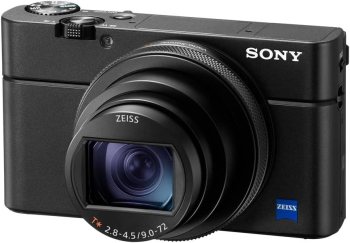- Compact and lightweight
- Excellent image quality
- Fast autofocus
- Exceptional video quality
- Outstanding low-light performance
- Robust build quality
- Limited battery life
- Small control buttons
- No headphone jack
- Expensive
- Limited still photo resolution
- Heavy body
Sony Cyber-shot RX100 VII vs Sony Alpha 7S III
When it comes to sony digital cameras, two models that stand out for their exceptional quality and features are the Sony Cyber-shot RX100 VII and the Sony Alpha 7S III. While both cameras are designed to capture stunning images and videos, they cater to different needs and offer distinct advantages. In this comparison, we'll delve into the details of each camera to help you decide which one is best suited for your photography or videography requirements.
Design and Build
The Sony Cyber-shot RX100 VII is a compact point-and-shoot camera that measures 4 inches wide, 2.3 inches tall, and 1.7 inches deep. It weighs approximately 10.7 ounces, making it an ideal choice for travelers, vloggers, or anyone who wants a high-quality camera that can fit in their pocket. The camera features a sleek design with a pop-up electronic viewfinder, a tilting LCD screen, and a robust build quality.
In contrast, the Sony Alpha 7S III is a full-frame mirrorless camera that measures 5 inches wide, 3.8 inches tall, and 2.9 inches deep. It weighs around 25.9 ounces, which is significantly heavier than the RX100 VII. The A7S III features a more substantial build with a magnesium alloy body, weather sealing, and a larger grip for better handling.
Image Quality
Both cameras are equipped with excellent sensors, but they differ in terms of size and resolution. The Sony Cyber-shot RX100 VII features a 1-inch stacked CMOS sensor with 20.1 megapixels, while the Sony Alpha 7S III boasts a full-frame Exmor R CMOS sensor with 12.2 megapixels. Although the A7S III has fewer megapixels, its larger sensor size provides better low-light performance, dynamic range, and overall image quality.
In terms of still image quality, the A7S III excels in capturing detailed images with excellent color accuracy and contrast. The RX100 VII also produces outstanding images, but its smaller sensor size may result in slightly noisier images at higher ISOs.
Video Capabilities
Both cameras are capable of recording stunning videos, but they cater to different needs. The Sony Cyber-shot RX100 VII can record 4K video at up to 30p, while the Sony Alpha 7S III can record 4K video at up to 120p. The A7S III also features improved autofocus, enhanced color grading options, and better low-light performance, making it an excellent choice for professional videographers.
The RX100 VII is more suited for casual videography, vlogging, or recording events, while the A7S III is designed for more demanding video applications, such as filmmaking, documentaries, or live events.
Autofocus and Burst Mode
The Sony Alpha 7S III features Sony's advanced autofocus system with 759 phase-detection points, covering approximately 92% of the sensor area. This results in fast and accurate subject tracking, even in challenging lighting conditions. The camera can also shoot up to 10 frames per second (fps) in burst mode.
The Sony Cyber-shot RX100 VII features a faster burst mode, capable of shooting up to 20 fps, but its autofocus system is not as advanced as the A7S III. However, it still provides fast and accurate subject tracking, making it suitable for capturing wildlife, sports, or other fast-moving subjects.
Conclusion
When choosing between the Sony Cyber-shot RX100 VII and the Sony Alpha 7S III, consider your specific needs and preferences. If you're looking for a compact, versatile camera for casual photography and videography, the RX100 VII is an excellent choice. However, if you require a more advanced camera with exceptional image quality, improved autofocus, and enhanced video capabilities, the A7S III is the better option.
As part of the sony digital cameras lineup, both models offer outstanding performance, features, and value. Ultimately, the decision comes down to your specific requirements, budget, and personal preferences. Whether you choose the RX100 VII or the A7S III, you can be confident that you're investing in a high-quality camera that will help you capture stunning images and videos.































